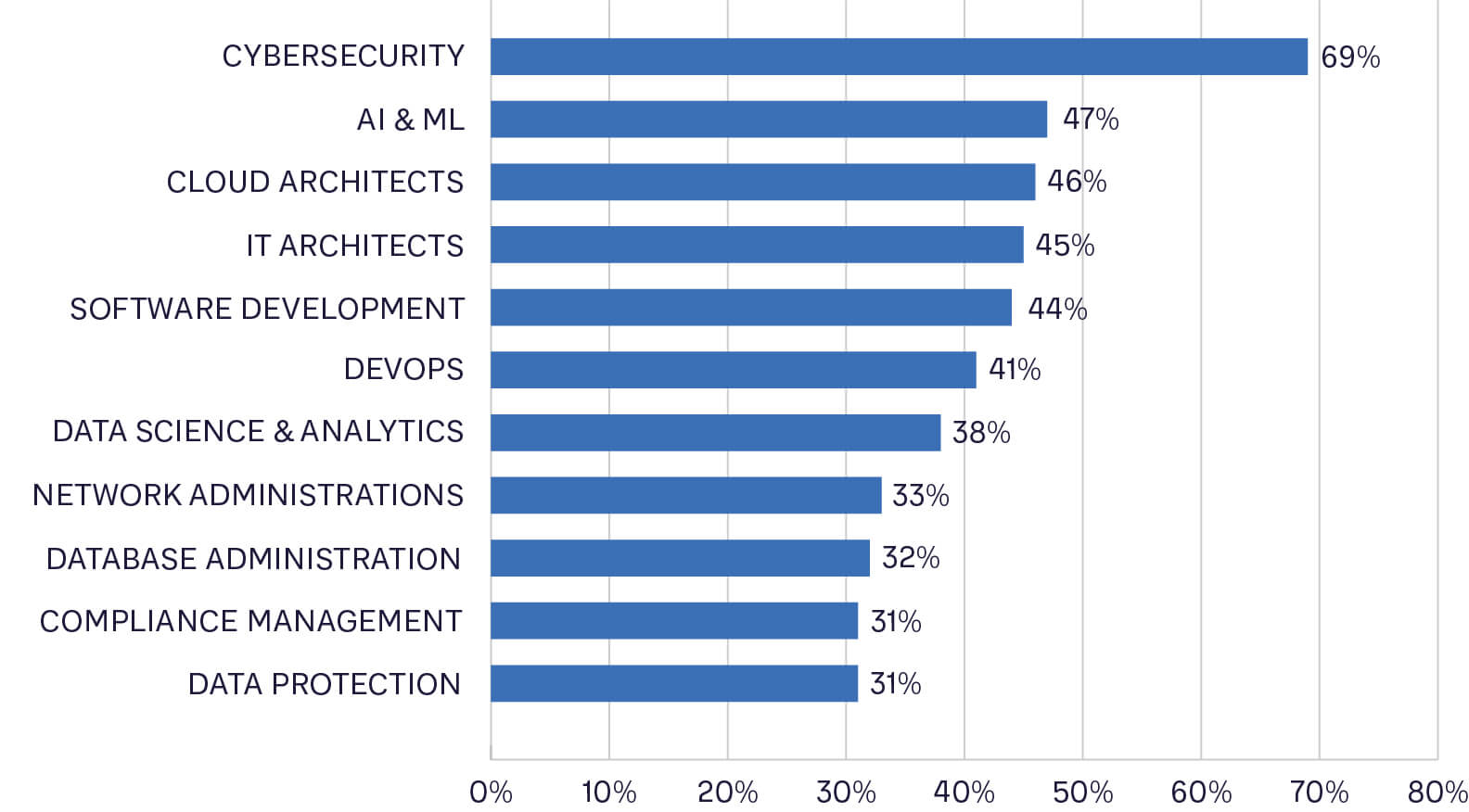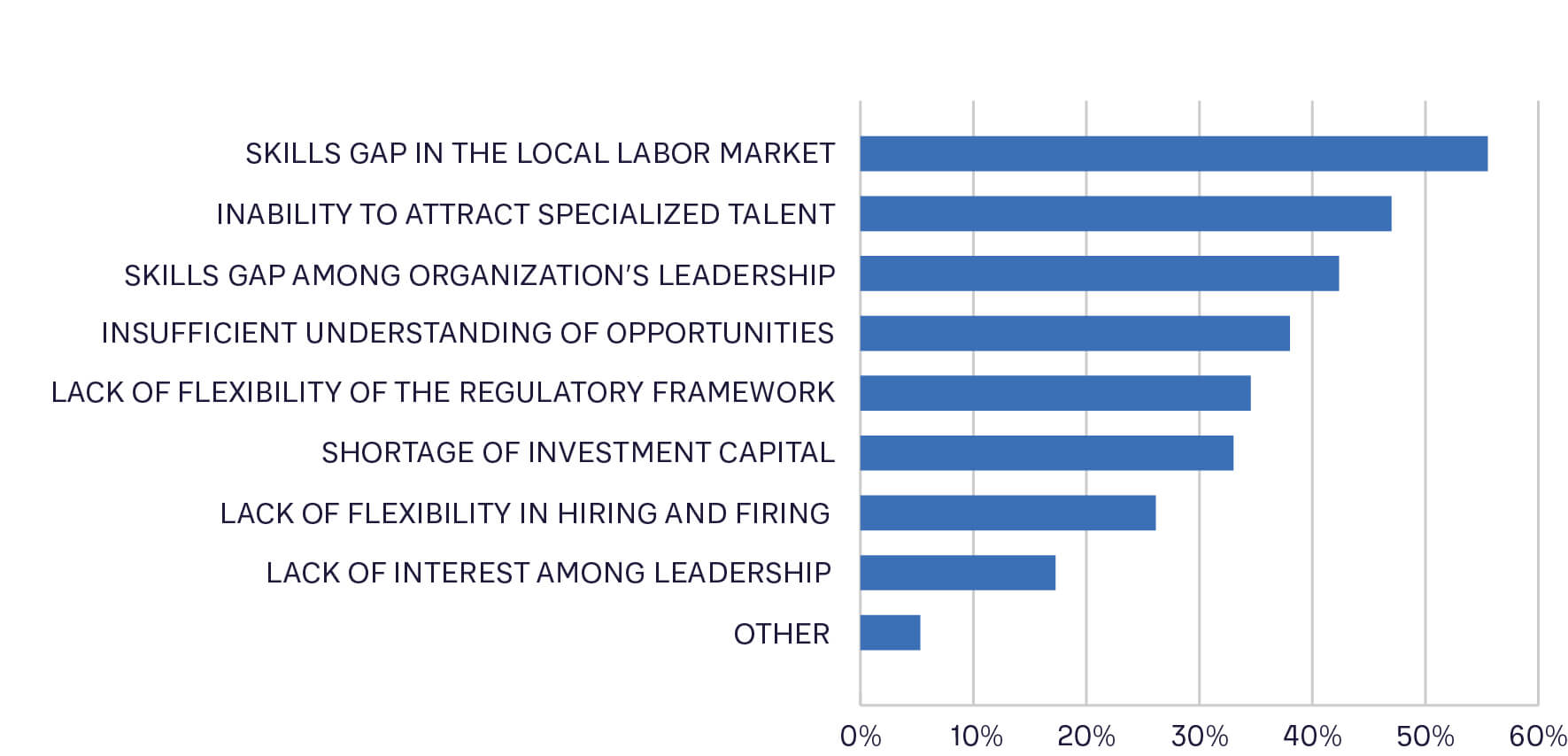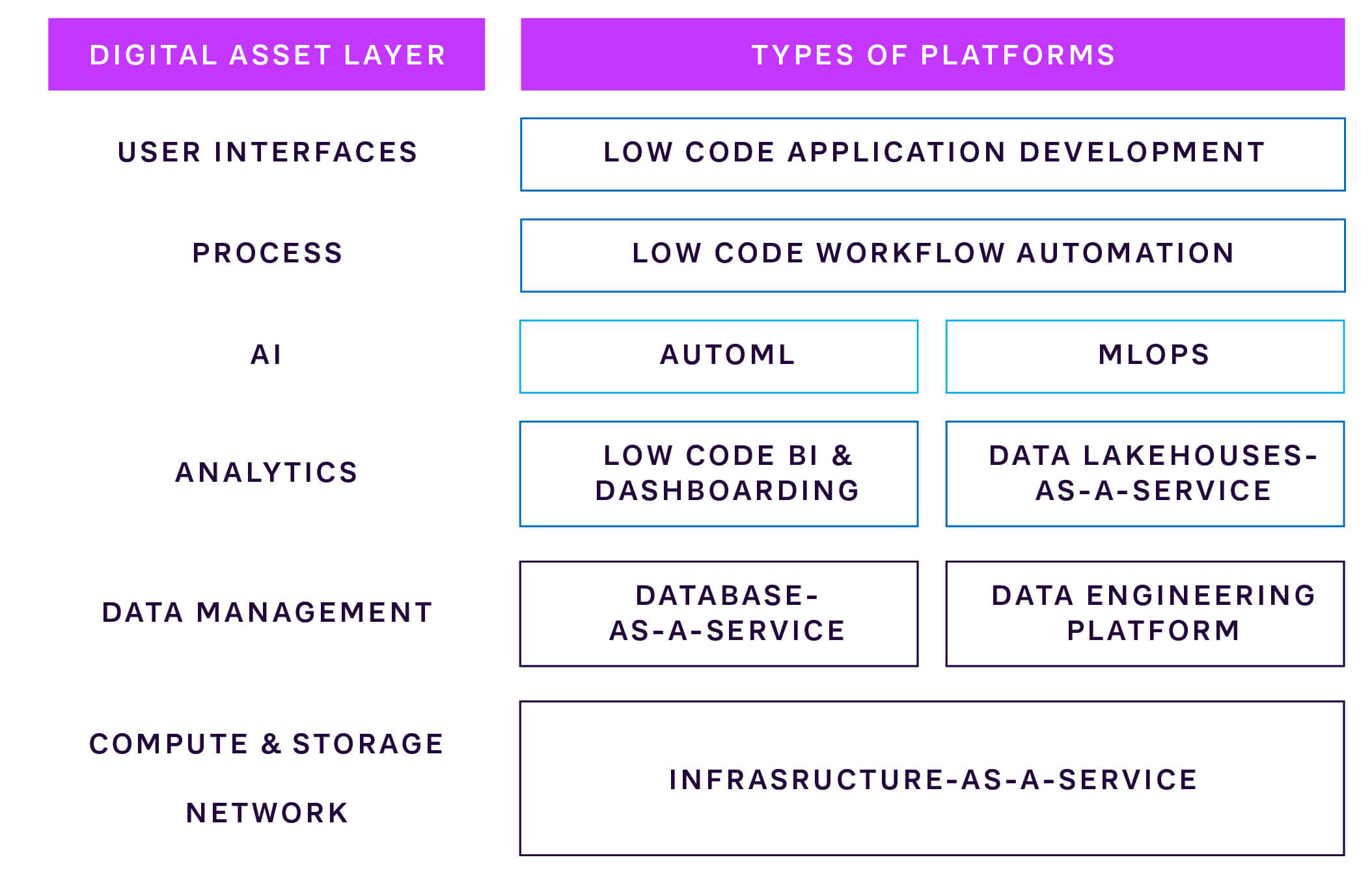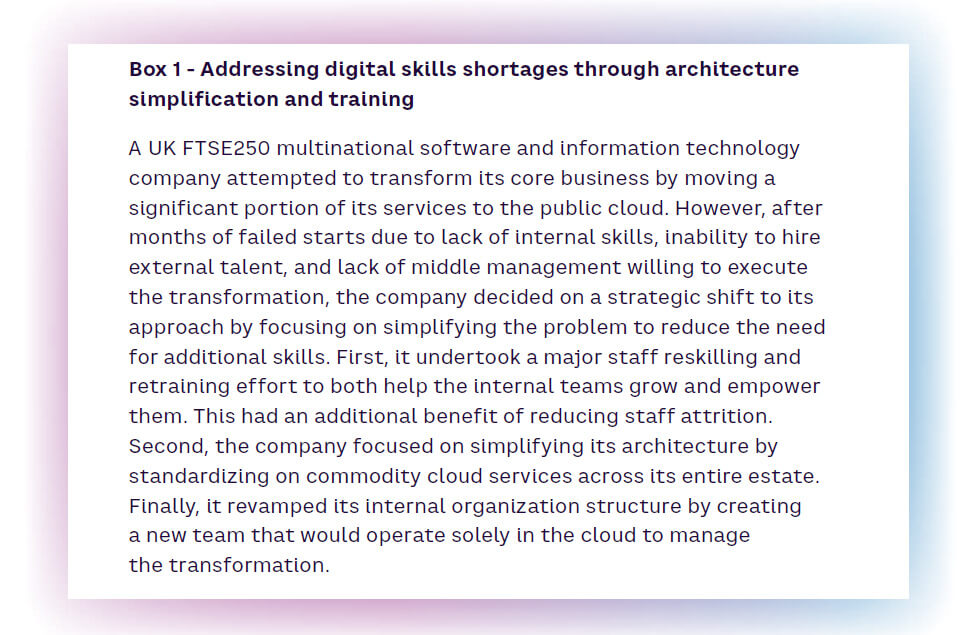15 min read • Technology & innovation management
Winning the war for digital talent
Looking beyond outsourcing

Businesses across the world are facing a shortage of professional talent and expertise in digital and IT skills and capabilities. For example, a 2021 survey suggested that 76 percent of IT decision-makers worldwide faced critical skills gaps in their departments, an increase of 145 percent since 2016.[1]
Over the past decades, the standard response to dealing with this issue has always been “outsourcing”. The huge revenue growth over the last 15 years of companies such as Tata Consultancy Services, Wipro, HCL, Infosys, Accenture, Capgemini, and Atos underlines how prevalent the “just outsource and offshore” solution has become.
Yet, while outsourcing will always have a place as part of the solution to the provision of digital skills and capabilities, it is no longer the panacea it used to be. This is because digital skills are now at the core of business operations. Approximately 90 percent of all operations in an average organization today are supported by software, and digital skills will become increasingly core with the further “softwarization” of products, services and experiences. Competence in digital channels, and in creating and managing omnichannel customer journeys, are crucial for both B2B and B2C businesses.
There is also rapid acceleration in adoption of disruptive technologies such as artificial intelligence (AI), machine learning (ML), the Internet of Things (IoT) and robotic process automation (RPA) – for example, a recent World Economic Forum survey indicated that some threequarters of companies were adopting IoT, ML and big data analytics technologies.[2] These technologies require upgraded skills from staff to manage and gain value from them. There are also growing concerns about cybersecurity, for which overall “cyber-savviness” is becoming increasingly important. All of this means digital skills are now one of the key determinants of competitiveness, value creation and business resilience. Therefore, from a strategic point of view, simply outsourcing digital and IT is becoming much less desirable – leaving aside the commercial implications of paying a third party to manage increasingly large parts of core operations. In this article we look at some effective strategies businesses are adopting to address the digital skills gap as an alternative, or at least a complement, to outsourcing.
All of this means digital skills are now one of the key determinants of competitiveness, value creation and business resilience. Therefore, from a strategic point of view, simply outsourcing digital and IT is becoming much less desirable – leaving aside the commercial implications of paying a third party to manage increasingly large parts of core operations.
In this article we look at some effective strategies businesses are adopting to address the digital skills gap as an alternative, or at least a complement, to outsourcing.
THE NATURE OF THE CHALLENGE
The demand for professional digital and IT capabilities has soared over the last decade, driven by the digitalization of businesses. This has led to a shortage in skills across a broad range of specialist digital domains, with the biggest shortage currently being in cybersecurity, followed by artificial intelligence/machine learning (AI/ML) and cloud architecture/planning. The results from a short survey across our global client base in late 2021 are shown in Figure 1.

This is further backed by far wider surveys, such as the World Economic Forum 2020 reports. These show that skills gaps – either in local capability, leadership or failure to attract specialists – are perceived as the main barriers to digital transformations and new technology adoption.

In general, businesses have been slow to recognize the strategic implications of this challenge. There are several reasons for this:
- Organizations have spent years establishing bureaucracies formed of management layers that are unable to create software solutions themselves; these are aimed instead at managing software creation by third parties, effectively offloading creation capability to externals. This made sense at the time because the targeted capabilities were, to a large extent, commoditized and nondifferentiating. In this situation, an external software development arm was cheaper, more effective, and easier to manage than an internal one.
- The skills required to work with new digital technologies are increasingly hard to specify and gauge, and even harder to manage. Indeed, embedding these skills requires a more hands-on approach than in the past, because of the tight collaboration needed between the specialists and the rest of the organization to deliver software-enabled transformation. This means firms often fail to recognize capability gaps quickly enough, or think only about specialist skills, rather than the broader culture and operating model.
- As the market economy has continued to expand, firms have become accustomed to being limited by their capacity to find buyers for their products, rather by their capacity to produce those products. Generally, in the past the market has been able to meet demands for digital services. This is no longer necessarily the case, even with the growth of global IT outsourcing giants.
HOW TO ADDRESS THE SKILLS SHORTAGE EFFECTIVELY
To solve these problems, companies need to take a more strategic and comprehensive approach that goes beyond outsourcing. For example, Joseph Fuller, writing for Harvard Business School, argues: “Business leaders must champion an employer-led skills-development system, in which they bring the type of rigor and discipline to sourcing middleskills talent that they historically applied to their materials supply chains.” Indeed, skills shortages are not just confined to digital. Over the last few years, accelerated by the pandemic, record numbers of employees have quit their jobs as they reassessed the balances and trade-offs of their lives. This is the subject of the lead article in the May-June 2022 Harvard Business Review, “Designing Work That People Love.” With this in mind, we see three complementary approaches for companies to take, which together effectively address both the supply and demand sides of the digital skills challenges: first, become better at engaging the right new resources externally; second, use the right approaches for skills transformation; and third, manage the digital and IT estate strategically to reduce skills demands.
1. BECOME BETTER AT ENGAGING THE RIGHT NEW RESOURCES EXTERNALLY
Being able to engage and retain the right resources is at the heart of the problem. There are three basic ways to make sure you have access to the right skilled resources in specialized areas such as software and data engineering:
- Making your company more attractive to the sort of people you want to recruit and retain
- Building strategic partnerships with IT service providers and the ecosystem
- Acquiring start-ups focused on the key skills you need
Looking at the first of these, it is key to create an environment that can be clearly seen as stimulating to data and IT engineers, allowing them to work on key strategic challenges while keeping a certain level of freedom and independence. The balancing act that all employers will have to find is how to deal with the above-mentioned engineers’ preferences, while ensuring added value for the company.
This means defining a technology governance approach that is sufficiently open and architecturally decoupled from the legacy IT, while sharing some foundations that would ease the retrofit onto the operations. Companies such as TotalEnergies, Thales, SNCB and Air France have recently invested in large-scale digital factories that have created the “start-up” culture in a sidecar of the main company. Some of these have even become independent entities owned by the mothership.
In building strategic partnerships with external professional service providers, the key success factor is how best to infuse this external experience and knowledge into the client’s employees, rather than just outsourcing. A number of tactics are effective in this process, such as co-locating in-house and partner teams, forming mixed internal/external scrum teams, and setting up internal organization maturityled contract rewards. The worst thing companies can do is outsource their problem and try to forget about it – so many famous potential partnerships have failed over the years because the CIO was in this purely contractual mind-set.
Finally, when acquiring start-ups, the main challenge involves maintaining the nimbleness of the acquired company by not going a bridge too far into the integration journey, which can easily kill its creativity and attractiveness. For example, we have recently seen a case in which a successful start-up was acquired by a global telco company that effectively killed it off through rebadging its team members and insisting they used the telco’s standardized templates. The end result was that over 75 percent of the start-up’s staff left within two years of the acquisition.
The key challenge for employers is not to destroy value, which can quickly happen when dealing with human resources. An important prerequisite for preserving value is for the chief information officer’s and/or chief digital officer’s ambitions and objectives to seamlessly contribute to the corporate strategy.
2. USE THE RIGHT APPROACHES FOR SKILLS TRANSFORMATION
In the past, big companies that needed to organize skills transformation were in the habit of sending large numbers of their employees to central training centers in fancy locations. However, in recent years, most companies have changed their approach, often as a consequence of the pandemic, growing consciousness of carbon footprints and social responsibility, and the realization that the return on investment was limited.
For one thing, massive transformation programs now tend to be located in hardcore digital hubs, such as Bengaluru, rather than sunny leisure locations. However, the companies that have most successfully pivoted towards digital have evolved their skill transformation programs to be segmented, specific and immersive:
- Segmentation is important because there is no one size fits all. Some employees will need to become power users, and some much less so. The level of desired target awareness needs to be the lead criterion when segmenting participants – from full stack engineer down to product owner.
- Specificity is important because the topic can be very broad. Data will lead you to AI, which will inevitably lead you to the cloud – and the technologies behind these will probably look different 18–24 months from now. That is why, more and more often, we are seeing the concept of developing one’s “TQ” kicking in. TQ stands for technology quotient, analogous with intelligence quotient (IQ) and emotional quotient (EQ). TQ measures the ability of an individual to assimilate or adapt to technology changes by developing and employing strategies to successfully include technology in their work and life. A high TQ implies the right attitude, capabilities and decision-making strategies to fully leverage technology. For many employees, developing their TQ is a valuable objective to pursue in addition to specific technical competencies. Developing TQ has already become a mainstream objective in many organizations.
- Immersivity is important because digital can only be learned hands-on. While in the past this meant sitting behind a computer and fighting against a compiler to execute your code lines, today new techniques have evolved, enabled by gamification. In some companies, employees nowadays receive, as part of their welcome goodies such as a hoodie and a reusable water bottle, a virtual reality headset and access to the metaverse to attend a virtual classroom on their first working day.[3]
3. MANAGE THE DIGITAL AND IT ESTATE STRATEGICALLY TO REDUCE SKILLS DEMANDS
From an architectural point of view, companies must focus more on ensuring that their IT and digital estate does not require unnecessary amounts of tech skills or unnecessarily skilled tech resources. Simplicity has to be front of mind when making decisions about the estate and its architecture. Companies need to become ruthless at eliminating overhead in terms of the quantity or quality of skills required to develop and evolve technology solutions, as well as to operate them.
Unfortunately, more often than not, companies have made the “digital transformation” years more difficult for themselves by allowing avoidable complexity to creep in, typically in the following areas:
- Unnecessarily customized solutions overlooking available commodity technology
- Unnecessarily complex architectures for custom solutions In many cases, this has led to an explosion of the breadth of skills and technologies deployed in the tech estate.
In order to reduce unnecessary complexity and help lower the volume and quality of tech skills required over time to develop and maintain the estate, there are eight things that companies should consider:
- Consider standardized and commoditized software solutions. Buying off the shelf, or better, Software-as-a-Service (SaaS), literally allows you to delegate software development and maintenance to another entity for good, as long as the solutions are open enough to nicely integrate with the rest of the estate. Also, the less specific to you something is, the more widely available the skills are. Of course, you still need to follow the “buy for competitive parity” and “build for competitive advantage” rules, but it pays to think much harder about what competitive advantage really means for you before jumping to customize.
- Use the simplest-possible solution architectures. When a custom solution is indeed the right choice, technologists often want to try the latest technology and architectural concepts without any real justification for the case in point. However, these generally come with a cost in terms of complexity and availability of skills (for example, Big Data or microservices). Worse, these impacts are often felt most acutely and regretfully later on, when it comes to evolving and maintaining the solution.
- Use higher-level abstraction platforms for your use case. From infrastructure to data management or application development, platforms exist for every layer that makes up digital assets to take care of and abstract lower-level considerations and allow companies to create custom products on top of them. This allows for simpler and speedier implementation, simpler required skill sets limited to technical layers above the platform, and lower overall operational effort with minimal overhead. As a rule of thumb, the highest-possible abstraction platform on which your custom software use case can run is the one you should choose. In this category, you will find familiar concepts such as cloud infrastructure providers, cloud analytics and data platforms, low-code application or workflow development, and low-code analytics/dashboarding solutions (see Figure 3): For example, building a digital asset on a low code application development platform requires less advanced technical skills that can be more easily learned or acquired. The lower layers, such as infrastructure and data management, will not need specialized resources to look after them. The key is to standardize the platforms at each layer and assess the highest platform level that can be used for each use case.
- Consider sourcing externally. Sourcing externally certainly has a place if it helps you drive one of the points listed above. In particular, sourcing externally is a good choice for building a non-differentiating technology asset based on a commoditized offering, building a platform that will make delivering future developments faster and simpler, or simplifying an estate or existing technology solution. It is also a valid choice to build a custom and differentiating asset using skill sets you do not yet fully possess (such as AI), as long as staff upskilling and interim managed services arrangements are part of the deal.
- Standardize. Choosing established technology stacks, platforms and tools that should be used unless proven otherwise helps to rein in the array of talent required to maintain and evolve the estate. It also helps focus a company’s resources on a few welldefined training and upskilling programs, while fostering inhouse expertise and specialization. Reality has caught up with concepts such as “polyglot programming,”[4] which was all about using the right language for the job, but in practice has often led to organizations ending up with far too many programming languages.
- Make your tech culture one of end-to-end efficiency. Software asset development and operation is a relatively new discipline, and remarkable improvements have been made to improve efficiency and quality in software delivery over the last 20 years – for example, continuous delivery, automated testing, and DevOps.[5] Existing technical teams should be upskilled in these. More importantly, they should be made to adopt a culture of constant reflection around end-to-end software delivery efficiency gains that allows a finite set of resources to achieve more.
- Exploit the potential of AI where possible. AI and ML can also help organizations address skills shortages, such as by automating tasks for skilled workers so they can be more productive, or by using AI-assisted learning or employee engagement. AI is applied to a wide variety of use cases today, in areas such as IT operations, security and threat detection. Public cloud providers and other third-party vendors offer a plethora of powerful tools that can help with cyber-security, application performance and general automation. Beyond IT operations, companies are applying AI and natural language processing to customer-facing fields such as marketing, sales and customer care in the form of chatbots to route or even fulfil requests, as well as social listening and sentiment analysis. We estimate that at least one-third of companies are already experimenting with AI in this space. However, AI adoption is one of the areas that itself is severely hampered by the skills shortage. In fact, more than costs, lack of tools, or project or data complexity, the skills gap remains the biggest barrier to AI adoption. Using high-level abstracted platforms such as auto ML services can go a long way in generating value from AI with lower technical skills. (See also point 3 above relating to platforms.)
- Empower your employees to self-manage. Technology such as standardized low-code/no-code platforms[6] can effectively allow employees to self-manage using standardized technology platforms. This can alleviate the need for specialist IT skills, as well as help eliminate silos and create new functionality and capability. However, it also requires the right process environment to allow your workforce to act in an empowered way, while also keeping strong guard rails in place to keep things secure, performant and cost-effective.

Box 1 shows an example of these principles being applied in practice.

INSIGHTS FOR THE EXECUTIVE
The digital skills shortage presents a tangible risk to every business and organization – especially since “software is eating the world” and every organization is now practically a technology company. The skills shortage is a risk to both business resilience and growth and innovation, as there is a near-constant drive for adoption of new technologies for organizations to compete and grow. Simply outsourcing is becoming undesirable as the sole solution as digital skills become increasingly core to maintaining competitive advantage and ensuring business resilience. There are a few tactical moves to help with the digital skills shortage in the short term – such as constantly raising compensation – but those eventually become unsustainable. The real change needed is to transform the culture and practice around digital, diversifying and broadening the technical expertise of the workforce, nurturing a business sense among digital and IT resources, and enabling employees to focus on problem solving. Companies can not only address the skills shortage, but also create more business value, by managing digital resources more strategically. This involves focusing on a combination of measures around better accessing and retaining resources, improving skills transformation practices and, most importantly, managing the digital estate to reduce skills demand.
Notes
[1] Skillsoft’s Global Knowledge 2021 IT Skills and Salary Report
[2] Source: The Future of Jobs Report 2018, World Economic Forum
[3] At Accenture, 150,000 new hires will spend their first day of work in the metaverse – Fortune (ampproject.org)
[4] https://www.thoughtworks.com/en-gb/insights/articles/radar-hits-misses
[5] DevOps is a combination of the terms “development” and “operations”, meant to represent a collaborative or shared approach to the tasks performed by a company’s application development and IT operations teams
[6] See also “Unleashing innovation using low code/no code – The age of the citizen developer” [Prism 1 2020]

15 min read • Technology & innovation management
Winning the war for digital talent
Looking beyond outsourcing

DATE

Businesses across the world are facing a shortage of professional talent and expertise in digital and IT skills and capabilities. For example, a 2021 survey suggested that 76 percent of IT decision-makers worldwide faced critical skills gaps in their departments, an increase of 145 percent since 2016.[1]
Over the past decades, the standard response to dealing with this issue has always been “outsourcing”. The huge revenue growth over the last 15 years of companies such as Tata Consultancy Services, Wipro, HCL, Infosys, Accenture, Capgemini, and Atos underlines how prevalent the “just outsource and offshore” solution has become.
Yet, while outsourcing will always have a place as part of the solution to the provision of digital skills and capabilities, it is no longer the panacea it used to be. This is because digital skills are now at the core of business operations. Approximately 90 percent of all operations in an average organization today are supported by software, and digital skills will become increasingly core with the further “softwarization” of products, services and experiences. Competence in digital channels, and in creating and managing omnichannel customer journeys, are crucial for both B2B and B2C businesses.
There is also rapid acceleration in adoption of disruptive technologies such as artificial intelligence (AI), machine learning (ML), the Internet of Things (IoT) and robotic process automation (RPA) – for example, a recent World Economic Forum survey indicated that some threequarters of companies were adopting IoT, ML and big data analytics technologies.[2] These technologies require upgraded skills from staff to manage and gain value from them. There are also growing concerns about cybersecurity, for which overall “cyber-savviness” is becoming increasingly important. All of this means digital skills are now one of the key determinants of competitiveness, value creation and business resilience. Therefore, from a strategic point of view, simply outsourcing digital and IT is becoming much less desirable – leaving aside the commercial implications of paying a third party to manage increasingly large parts of core operations. In this article we look at some effective strategies businesses are adopting to address the digital skills gap as an alternative, or at least a complement, to outsourcing.
All of this means digital skills are now one of the key determinants of competitiveness, value creation and business resilience. Therefore, from a strategic point of view, simply outsourcing digital and IT is becoming much less desirable – leaving aside the commercial implications of paying a third party to manage increasingly large parts of core operations.
In this article we look at some effective strategies businesses are adopting to address the digital skills gap as an alternative, or at least a complement, to outsourcing.
THE NATURE OF THE CHALLENGE
The demand for professional digital and IT capabilities has soared over the last decade, driven by the digitalization of businesses. This has led to a shortage in skills across a broad range of specialist digital domains, with the biggest shortage currently being in cybersecurity, followed by artificial intelligence/machine learning (AI/ML) and cloud architecture/planning. The results from a short survey across our global client base in late 2021 are shown in Figure 1.

This is further backed by far wider surveys, such as the World Economic Forum 2020 reports. These show that skills gaps – either in local capability, leadership or failure to attract specialists – are perceived as the main barriers to digital transformations and new technology adoption.

In general, businesses have been slow to recognize the strategic implications of this challenge. There are several reasons for this:
- Organizations have spent years establishing bureaucracies formed of management layers that are unable to create software solutions themselves; these are aimed instead at managing software creation by third parties, effectively offloading creation capability to externals. This made sense at the time because the targeted capabilities were, to a large extent, commoditized and nondifferentiating. In this situation, an external software development arm was cheaper, more effective, and easier to manage than an internal one.
- The skills required to work with new digital technologies are increasingly hard to specify and gauge, and even harder to manage. Indeed, embedding these skills requires a more hands-on approach than in the past, because of the tight collaboration needed between the specialists and the rest of the organization to deliver software-enabled transformation. This means firms often fail to recognize capability gaps quickly enough, or think only about specialist skills, rather than the broader culture and operating model.
- As the market economy has continued to expand, firms have become accustomed to being limited by their capacity to find buyers for their products, rather by their capacity to produce those products. Generally, in the past the market has been able to meet demands for digital services. This is no longer necessarily the case, even with the growth of global IT outsourcing giants.
HOW TO ADDRESS THE SKILLS SHORTAGE EFFECTIVELY
To solve these problems, companies need to take a more strategic and comprehensive approach that goes beyond outsourcing. For example, Joseph Fuller, writing for Harvard Business School, argues: “Business leaders must champion an employer-led skills-development system, in which they bring the type of rigor and discipline to sourcing middleskills talent that they historically applied to their materials supply chains.” Indeed, skills shortages are not just confined to digital. Over the last few years, accelerated by the pandemic, record numbers of employees have quit their jobs as they reassessed the balances and trade-offs of their lives. This is the subject of the lead article in the May-June 2022 Harvard Business Review, “Designing Work That People Love.” With this in mind, we see three complementary approaches for companies to take, which together effectively address both the supply and demand sides of the digital skills challenges: first, become better at engaging the right new resources externally; second, use the right approaches for skills transformation; and third, manage the digital and IT estate strategically to reduce skills demands.
1. BECOME BETTER AT ENGAGING THE RIGHT NEW RESOURCES EXTERNALLY
Being able to engage and retain the right resources is at the heart of the problem. There are three basic ways to make sure you have access to the right skilled resources in specialized areas such as software and data engineering:
- Making your company more attractive to the sort of people you want to recruit and retain
- Building strategic partnerships with IT service providers and the ecosystem
- Acquiring start-ups focused on the key skills you need
Looking at the first of these, it is key to create an environment that can be clearly seen as stimulating to data and IT engineers, allowing them to work on key strategic challenges while keeping a certain level of freedom and independence. The balancing act that all employers will have to find is how to deal with the above-mentioned engineers’ preferences, while ensuring added value for the company.
This means defining a technology governance approach that is sufficiently open and architecturally decoupled from the legacy IT, while sharing some foundations that would ease the retrofit onto the operations. Companies such as TotalEnergies, Thales, SNCB and Air France have recently invested in large-scale digital factories that have created the “start-up” culture in a sidecar of the main company. Some of these have even become independent entities owned by the mothership.
In building strategic partnerships with external professional service providers, the key success factor is how best to infuse this external experience and knowledge into the client’s employees, rather than just outsourcing. A number of tactics are effective in this process, such as co-locating in-house and partner teams, forming mixed internal/external scrum teams, and setting up internal organization maturityled contract rewards. The worst thing companies can do is outsource their problem and try to forget about it – so many famous potential partnerships have failed over the years because the CIO was in this purely contractual mind-set.
Finally, when acquiring start-ups, the main challenge involves maintaining the nimbleness of the acquired company by not going a bridge too far into the integration journey, which can easily kill its creativity and attractiveness. For example, we have recently seen a case in which a successful start-up was acquired by a global telco company that effectively killed it off through rebadging its team members and insisting they used the telco’s standardized templates. The end result was that over 75 percent of the start-up’s staff left within two years of the acquisition.
The key challenge for employers is not to destroy value, which can quickly happen when dealing with human resources. An important prerequisite for preserving value is for the chief information officer’s and/or chief digital officer’s ambitions and objectives to seamlessly contribute to the corporate strategy.
2. USE THE RIGHT APPROACHES FOR SKILLS TRANSFORMATION
In the past, big companies that needed to organize skills transformation were in the habit of sending large numbers of their employees to central training centers in fancy locations. However, in recent years, most companies have changed their approach, often as a consequence of the pandemic, growing consciousness of carbon footprints and social responsibility, and the realization that the return on investment was limited.
For one thing, massive transformation programs now tend to be located in hardcore digital hubs, such as Bengaluru, rather than sunny leisure locations. However, the companies that have most successfully pivoted towards digital have evolved their skill transformation programs to be segmented, specific and immersive:
- Segmentation is important because there is no one size fits all. Some employees will need to become power users, and some much less so. The level of desired target awareness needs to be the lead criterion when segmenting participants – from full stack engineer down to product owner.
- Specificity is important because the topic can be very broad. Data will lead you to AI, which will inevitably lead you to the cloud – and the technologies behind these will probably look different 18–24 months from now. That is why, more and more often, we are seeing the concept of developing one’s “TQ” kicking in. TQ stands for technology quotient, analogous with intelligence quotient (IQ) and emotional quotient (EQ). TQ measures the ability of an individual to assimilate or adapt to technology changes by developing and employing strategies to successfully include technology in their work and life. A high TQ implies the right attitude, capabilities and decision-making strategies to fully leverage technology. For many employees, developing their TQ is a valuable objective to pursue in addition to specific technical competencies. Developing TQ has already become a mainstream objective in many organizations.
- Immersivity is important because digital can only be learned hands-on. While in the past this meant sitting behind a computer and fighting against a compiler to execute your code lines, today new techniques have evolved, enabled by gamification. In some companies, employees nowadays receive, as part of their welcome goodies such as a hoodie and a reusable water bottle, a virtual reality headset and access to the metaverse to attend a virtual classroom on their first working day.[3]
3. MANAGE THE DIGITAL AND IT ESTATE STRATEGICALLY TO REDUCE SKILLS DEMANDS
From an architectural point of view, companies must focus more on ensuring that their IT and digital estate does not require unnecessary amounts of tech skills or unnecessarily skilled tech resources. Simplicity has to be front of mind when making decisions about the estate and its architecture. Companies need to become ruthless at eliminating overhead in terms of the quantity or quality of skills required to develop and evolve technology solutions, as well as to operate them.
Unfortunately, more often than not, companies have made the “digital transformation” years more difficult for themselves by allowing avoidable complexity to creep in, typically in the following areas:
- Unnecessarily customized solutions overlooking available commodity technology
- Unnecessarily complex architectures for custom solutions In many cases, this has led to an explosion of the breadth of skills and technologies deployed in the tech estate.
In order to reduce unnecessary complexity and help lower the volume and quality of tech skills required over time to develop and maintain the estate, there are eight things that companies should consider:
- Consider standardized and commoditized software solutions. Buying off the shelf, or better, Software-as-a-Service (SaaS), literally allows you to delegate software development and maintenance to another entity for good, as long as the solutions are open enough to nicely integrate with the rest of the estate. Also, the less specific to you something is, the more widely available the skills are. Of course, you still need to follow the “buy for competitive parity” and “build for competitive advantage” rules, but it pays to think much harder about what competitive advantage really means for you before jumping to customize.
- Use the simplest-possible solution architectures. When a custom solution is indeed the right choice, technologists often want to try the latest technology and architectural concepts without any real justification for the case in point. However, these generally come with a cost in terms of complexity and availability of skills (for example, Big Data or microservices). Worse, these impacts are often felt most acutely and regretfully later on, when it comes to evolving and maintaining the solution.
- Use higher-level abstraction platforms for your use case. From infrastructure to data management or application development, platforms exist for every layer that makes up digital assets to take care of and abstract lower-level considerations and allow companies to create custom products on top of them. This allows for simpler and speedier implementation, simpler required skill sets limited to technical layers above the platform, and lower overall operational effort with minimal overhead. As a rule of thumb, the highest-possible abstraction platform on which your custom software use case can run is the one you should choose. In this category, you will find familiar concepts such as cloud infrastructure providers, cloud analytics and data platforms, low-code application or workflow development, and low-code analytics/dashboarding solutions (see Figure 3): For example, building a digital asset on a low code application development platform requires less advanced technical skills that can be more easily learned or acquired. The lower layers, such as infrastructure and data management, will not need specialized resources to look after them. The key is to standardize the platforms at each layer and assess the highest platform level that can be used for each use case.
- Consider sourcing externally. Sourcing externally certainly has a place if it helps you drive one of the points listed above. In particular, sourcing externally is a good choice for building a non-differentiating technology asset based on a commoditized offering, building a platform that will make delivering future developments faster and simpler, or simplifying an estate or existing technology solution. It is also a valid choice to build a custom and differentiating asset using skill sets you do not yet fully possess (such as AI), as long as staff upskilling and interim managed services arrangements are part of the deal.
- Standardize. Choosing established technology stacks, platforms and tools that should be used unless proven otherwise helps to rein in the array of talent required to maintain and evolve the estate. It also helps focus a company’s resources on a few welldefined training and upskilling programs, while fostering inhouse expertise and specialization. Reality has caught up with concepts such as “polyglot programming,”[4] which was all about using the right language for the job, but in practice has often led to organizations ending up with far too many programming languages.
- Make your tech culture one of end-to-end efficiency. Software asset development and operation is a relatively new discipline, and remarkable improvements have been made to improve efficiency and quality in software delivery over the last 20 years – for example, continuous delivery, automated testing, and DevOps.[5] Existing technical teams should be upskilled in these. More importantly, they should be made to adopt a culture of constant reflection around end-to-end software delivery efficiency gains that allows a finite set of resources to achieve more.
- Exploit the potential of AI where possible. AI and ML can also help organizations address skills shortages, such as by automating tasks for skilled workers so they can be more productive, or by using AI-assisted learning or employee engagement. AI is applied to a wide variety of use cases today, in areas such as IT operations, security and threat detection. Public cloud providers and other third-party vendors offer a plethora of powerful tools that can help with cyber-security, application performance and general automation. Beyond IT operations, companies are applying AI and natural language processing to customer-facing fields such as marketing, sales and customer care in the form of chatbots to route or even fulfil requests, as well as social listening and sentiment analysis. We estimate that at least one-third of companies are already experimenting with AI in this space. However, AI adoption is one of the areas that itself is severely hampered by the skills shortage. In fact, more than costs, lack of tools, or project or data complexity, the skills gap remains the biggest barrier to AI adoption. Using high-level abstracted platforms such as auto ML services can go a long way in generating value from AI with lower technical skills. (See also point 3 above relating to platforms.)
- Empower your employees to self-manage. Technology such as standardized low-code/no-code platforms[6] can effectively allow employees to self-manage using standardized technology platforms. This can alleviate the need for specialist IT skills, as well as help eliminate silos and create new functionality and capability. However, it also requires the right process environment to allow your workforce to act in an empowered way, while also keeping strong guard rails in place to keep things secure, performant and cost-effective.

Box 1 shows an example of these principles being applied in practice.

INSIGHTS FOR THE EXECUTIVE
The digital skills shortage presents a tangible risk to every business and organization – especially since “software is eating the world” and every organization is now practically a technology company. The skills shortage is a risk to both business resilience and growth and innovation, as there is a near-constant drive for adoption of new technologies for organizations to compete and grow. Simply outsourcing is becoming undesirable as the sole solution as digital skills become increasingly core to maintaining competitive advantage and ensuring business resilience. There are a few tactical moves to help with the digital skills shortage in the short term – such as constantly raising compensation – but those eventually become unsustainable. The real change needed is to transform the culture and practice around digital, diversifying and broadening the technical expertise of the workforce, nurturing a business sense among digital and IT resources, and enabling employees to focus on problem solving. Companies can not only address the skills shortage, but also create more business value, by managing digital resources more strategically. This involves focusing on a combination of measures around better accessing and retaining resources, improving skills transformation practices and, most importantly, managing the digital estate to reduce skills demand.
Notes
[1] Skillsoft’s Global Knowledge 2021 IT Skills and Salary Report
[2] Source: The Future of Jobs Report 2018, World Economic Forum
[3] At Accenture, 150,000 new hires will spend their first day of work in the metaverse – Fortune (ampproject.org)
[4] https://www.thoughtworks.com/en-gb/insights/articles/radar-hits-misses
[5] DevOps is a combination of the terms “development” and “operations”, meant to represent a collaborative or shared approach to the tasks performed by a company’s application development and IT operations teams
[6] See also “Unleashing innovation using low code/no code – The age of the citizen developer” [Prism 1 2020]

